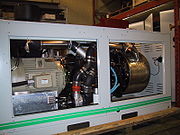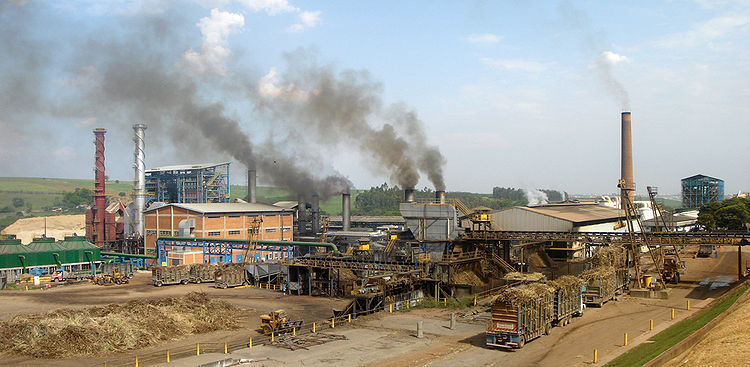
Bioenergy
Encyclopedia

Bioenergy is renewable energy
Renewable energy
Renewable energy is energy which comes from natural resources such as sunlight, wind, rain, tides, and geothermal heat, which are renewable . About 16% of global final energy consumption comes from renewables, with 10% coming from traditional biomass, which is mainly used for heating, and 3.4% from...
made available from materials derived from biological sources. Biomass is any organic material which has stored sunlight in the form of chemical energy. As a fuel it may include wood
Wood
Wood is a hard, fibrous tissue found in many trees. It has been used for hundreds of thousands of years for both fuel and as a construction material. It is an organic material, a natural composite of cellulose fibers embedded in a matrix of lignin which resists compression...
, wood waste, straw
Straw
Straw is an agricultural by-product, the dry stalks of cereal plants, after the grain and chaff have been removed. Straw makes up about half of the yield of cereal crops such as barley, oats, rice, rye and wheat. It has many uses, including fuel, livestock bedding and fodder, thatching and...
, manure
Manure
Manure is organic matter used as organic fertilizer in agriculture. Manures contribute to the fertility of the soil by adding organic matter and nutrients, such as nitrogen, that are trapped by bacteria in the soil...
, sugarcane
Sugarcane
Sugarcane refers to any of six to 37 species of tall perennial grasses of the genus Saccharum . Native to the warm temperate to tropical regions of South Asia, they have stout, jointed, fibrous stalks that are rich in sugar, and measure two to six metres tall...
, and many other byproducts from a variety of agricultural processes. By 2010, there was 35GW of globally installed bioenergy capacity for electricity generation, of which 7GW was in the US.
In its most narrow sense it is a synonym to biofuel
Biofuel
Biofuel is a type of fuel whose energy is derived from biological carbon fixation. Biofuels include fuels derived from biomass conversion, as well as solid biomass, liquid fuels and various biogases...
, which is fuel derived from biological sources. In its broader sense it includes biomass
Biomass
Biomass, as a renewable energy source, is biological material from living, or recently living organisms. As an energy source, biomass can either be used directly, or converted into other energy products such as biofuel....
, the biological material used as a biofuel, as well as the social, economic, scientific and technical fields associated with using biological sources for energy. This is a common misconception, as bioenergy is the energy extracted from the biomass, as the biomass is the fuel and the bioenergy is the energy contained in the fuel.
There is a slight tendency for the word bioenergy to be favoured in Europe compared with biofuel in North America.
Solid biomass

Biomass is material derived from recently living organism
Organism
In biology, an organism is any contiguous living system . In at least some form, all organisms are capable of response to stimuli, reproduction, growth and development, and maintenance of homoeostasis as a stable whole.An organism may either be unicellular or, as in the case of humans, comprise...
s, which includes plants, animals and their byproducts. Manure, garden waste and crop residues are all sources of biomass. It is a renewable energy source based on the carbon cycle
Carbon cycle
The carbon cycle is the biogeochemical cycle by which carbon is exchanged among the biosphere, pedosphere, geosphere, hydrosphere, and atmosphere of the Earth...
, unlike other natural resource
Natural resource
Natural resources occur naturally within environments that exist relatively undisturbed by mankind, in a natural form. A natural resource is often characterized by amounts of biodiversity and geodiversity existent in various ecosystems....
s such as petroleum
Petroleum
Petroleum or crude oil is a naturally occurring, flammable liquid consisting of a complex mixture of hydrocarbons of various molecular weights and other liquid organic compounds, that are found in geologic formations beneath the Earth's surface. Petroleum is recovered mostly through oil drilling...
, coal
Coal
Coal is a combustible black or brownish-black sedimentary rock usually occurring in rock strata in layers or veins called coal beds or coal seams. The harder forms, such as anthracite coal, can be regarded as metamorphic rock because of later exposure to elevated temperature and pressure...
, and nuclear
Nuclear reactor
A nuclear reactor is a device to initiate and control a sustained nuclear chain reaction. Most commonly they are used for generating electricity and for the propulsion of ships. Usually heat from nuclear fission is passed to a working fluid , which runs through turbines that power either ship's...
fuels. Another source includes Animal waste, which is a persistent and unavoidable pollutant
Pollutant
A pollutant is a waste material that pollutes air, water or soil, and is the cause of pollution.Three factors determine the severity of a pollutant: its chemical nature, its concentration and its persistence. Some pollutants are biodegradable and therefore will not persist in the environment in the...
produced primarily by the animals housed in industrial-sized farms.
There are also agricultural products specifically being grown for biofuel
Biofuel
Biofuel is a type of fuel whose energy is derived from biological carbon fixation. Biofuels include fuels derived from biomass conversion, as well as solid biomass, liquid fuels and various biogases...
production. These include corn
Maize
Maize known in many English-speaking countries as corn or mielie/mealie, is a grain domesticated by indigenous peoples in Mesoamerica in prehistoric times. The leafy stalk produces ears which contain seeds called kernels. Though technically a grain, maize kernels are used in cooking as a vegetable...
, and soybeans and to some extent willow
Willow
Willows, sallows, and osiers form the genus Salix, around 400 species of deciduous trees and shrubs, found primarily on moist soils in cold and temperate regions of the Northern Hemisphere...
and switchgrass
Switchgrass
Panicum virgatum, commonly known as switchgrass, is a perennial warm season bunchgrass native to North America, where it occurs naturally from 55°N latitude in Canada southwards into the United States and Mexico...
on a pre-commercial research level, primarily in the United States; rapeseed
Rapeseed
Rapeseed , also known as rape, oilseed rape, rapa, rappi, rapaseed is a bright yellow flowering member of the family Brassicaceae...
, wheat
Wheat
Wheat is a cereal grain, originally from the Levant region of the Near East, but now cultivated worldwide. In 2007 world production of wheat was 607 million tons, making it the third most-produced cereal after maize and rice...
, sugar beet
Sugar beet
Sugar beet, a cultivated plant of Beta vulgaris, is a plant whose tuber contains a high concentration of sucrose. It is grown commercially for sugar production. Sugar beets and other B...
, and willow (15,000 ha in Sweden) primarily in Europe; sugarcane in Brazil; palm oil
Palm oil
Palm oil, coconut oil and palm kernel oil are edible plant oils derived from the fruits of palm trees. Palm oil is extracted from the pulp of the fruit of the oil palm Elaeis guineensis; palm kernel oil is derived from the kernel of the oil palm and coconut oil is derived from the kernel of the...
and miscanthus
Miscanthus
Miscanthus is a genus of about 15 species of perennial grasses native to subtropical and tropical regions of Africa and southern Asia, with one species Miscanthus is a genus of about 15 species of perennial grasses native to subtropical and tropical regions of Africa and southern Asia, with one...
in Southeast Asia; sorghum
Sorghum
Sorghum is a genus of numerous species of grasses, one of which is raised for grain and many of which are used as fodder plants either cultivated or as part of pasture. The plants are cultivated in warmer climates worldwide. Species are native to tropical and subtropical regions of all continents...
and cassava
Cassava
Cassava , also called yuca or manioc, a woody shrub of the Euphorbiaceae native to South America, is extensively cultivated as an annual crop in tropical and subtropical regions for its edible starchy tuberous root, a major source of carbohydrates...
in China; and jatropha
Jatropha
Jatropha is a genus of approximately 175 succulent plants, shrubs and trees , from the family Euphorbiaceae. The name is derived from the Greek words ἰατρός , meaning "physician," and τροφή , meaning "nutrition," hence the common name physic nut. Mature plants produce separate male and female...
in India. Hemp
Hemp
Hemp is mostly used as a name for low tetrahydrocannabinol strains of the plant Cannabis sativa, of fiber and/or oilseed varieties. In modern times, hemp has been used for industrial purposes including paper, textiles, biodegradable plastics, construction, health food and fuel with modest...
has also been proven to work as a biofuel. Biodegradable outputs from industry, agriculture, forestry and households can be used for biofuel production, using e.g. anaerobic digestion
Anaerobic digestion
Anaerobic digestion is a series of processes in which microorganisms break down biodegradable material in the absence of oxygen. It is used for industrial or domestic purposes to manage waste and/or to release energy....
to produce biogas
Biogas
Biogas typically refers to a gas produced by the biological breakdown of organic matter in the absence of oxygen. Organic waste such as dead plant and animal material, animal dung, and kitchen waste can be converted into a gaseous fuel called biogas...
, gasification
Gasification
Gasification is a process that converts organic or fossil based carbonaceous materials into carbon monoxide, hydrogen, carbon dioxide and methane. This is achieved by reacting the material at high temperatures , without combustion, with a controlled amount of oxygen and/or steam...
to produce syngas
Syngas
Syngas is the name given to a gas mixture that contains varying amounts of carbon monoxide and hydrogen. Examples of production methods include steam reforming of natural gas or liquid hydrocarbons to produce hydrogen, the gasification of coal, biomass, and in some types of waste-to-energy...
or by direct combustion. Examples of biodegradable waste
Biodegradable waste
Biodegradable waste is a type of waste, typically originating from plant or animal sources, which may be degraded by other living organisms. Waste that cannot be broken down by other living organisms are called non-biodegradable....
s include straw, timber, manure, rice husks, sewage, and food waste. The use of biomass fuels can therefore contribute to waste management as well as fuel security and help to prevent or slow down climate change
Climate change
Climate change is a significant and lasting change in the statistical distribution of weather patterns over periods ranging from decades to millions of years. It may be a change in average weather conditions or the distribution of events around that average...
, although alone they are not a comprehensive solution to these problems.
Electricity generation from biomass
The biomass used for electricity production ranges by region. Forest by products, such as wood residues, are popular in the United StatesUnited States
The United States of America is a federal constitutional republic comprising fifty states and a federal district...
. Agricultural waste is common in Mauritius
Mauritius
Mauritius , officially the Republic of Mauritius is an island nation off the southeast coast of the African continent in the southwest Indian Ocean, about east of Madagascar...
(sugar cane residue) and Southeast Asia
Southeast Asia
Southeast Asia, South-East Asia, South East Asia or Southeastern Asia is a subregion of Asia, consisting of the countries that are geographically south of China, east of India, west of New Guinea and north of Australia. The region lies on the intersection of geological plates, with heavy seismic...
(rice husks). Animal husbandry residues, such as poultry litter, is popular in the UK.
Electricity from sugarcane bagasse in Brazil


The production process of sugar and ethanol in Brazil takes full advantage of the energy stored in sugarcane
Sugarcane
Sugarcane refers to any of six to 37 species of tall perennial grasses of the genus Saccharum . Native to the warm temperate to tropical regions of South Asia, they have stout, jointed, fibrous stalks that are rich in sugar, and measure two to six metres tall...
. Part of the bagasse is currently burned at the mill to provide heat for distillation and electricity to run the machinery. This allows ethanol plants to be energetically self-sufficient and even sell surplus electricity to utilities; current production is 600 MW for self-use and 100 MW for sale. This secondary activity is expected to boom now that utilities have been induced to pay "fair price "(about US$10/GJ or US$0.036/kWh) for 10 year contracts. This is approximately half of what the World Bank considers the reference price for investing in similar projects (see below). The energy is especially valuable to utilities because it is produced mainly in the dry season when hydroelectric dams are running low. Estimates of potential power generation from bagasse range from 1,000 to 9,000 MW, depending on technology. Higher estimates assume gasification of biomass, replacement of current low-pressure steam boilers and turbines by high-pressure ones, and use of harvest trash currently left behind in the fields. For comparison, Brazil's Angra I nuclear plant
Angra Nuclear Power Plant
Angra Nuclear Power Plant is Brazil's sole nuclear power plant. It is located at the Central Nuclear Almirante Álvaro Alberto on the Itaorna Beach in Angra dos Reis, Rio de Janeiro, Brazil...
generates 657 MW.
Presently, it is economically viable to extract about 288 MJ of electricity from the residues of one tonne of sugarcane, of which about 180 MJ are used in the plant itself. Thus a medium-size distillery processing 1 million tonnes of sugarcane per year could sell about 5 MW of surplus electricity. At current prices, it would earn US$ 18 million from sugar and ethanol sales, and about US$ 1 million from surplus electricity sales. With advanced boiler and turbine technology, the electricity yield could be increased to 648 MJ per tonne of sugarcane, but current electricity prices do not justify the necessary investment. (According to one report, the World Bank would only finance investments in bagasse power generation if the price were at least US$19/GJ or US$0.068/kWh.)
Bagasse burning is environmentally friendly
Environmentally friendly
Environmentally friendly are terms used to refer to goods and services, laws, guidelines and policies claimed to inflict minimal or no harm on the environment....
compared to other fuels like oil and coal. Its ash content is only 2.5% (against 30-50% of coal), and it contains very little sulfur. Since it burns at relatively low temperatures, it produces little nitrous oxides. Moreover, bagasse is being sold for use as a fuel (replacing heavy fuel oil) in various industries, including citrus juice concentrate, vegetable oil, ceramics, and tyre recycling. The state of São Paulo alone used 2 million tonnes, saving about US$ 35 million in fuel oil imports.
Researchers working with cellulosic ethanol
Cellulosic ethanol
Cellulosic ethanol is a biofuel produced from wood, grasses, or the non-edible parts of plants.It is a type of biofuel produced from lignocellulose, a structural material that comprises much of the mass of plants. Lignocellulose is composed mainly of cellulose, hemicellulose and lignin...
are trying to make the extraction of ethanol from sugarcane bagasse and other plants viable on an industrial scale.
External links
- Video: Where does bioenergy come from?
- Nordic Energy Solutions Bioenergy Solutions from the Nordic Region
- Research about the intersection of bioenergy, agriculture, and food security by the International Food Policy Research Institute.
- Biomass Reports (Idaho National LaboratoryIdaho National LaboratoryIdaho National Laboratory is an complex located in the high desert of eastern Idaho, between the town of Arco to the west and the cities of Idaho Falls and Blackfoot to the east. It lies within Butte, Bingham, Bonneville and Jefferson counties...
). - Bioenergy (Oak Ridge National LaboratoryOak Ridge National LaboratoryOak Ridge National Laboratory is a multiprogram science and technology national laboratory managed for the United States Department of Energy by UT-Battelle. ORNL is the DOE's largest science and energy laboratory. ORNL is located in Oak Ridge, Tennessee, near Knoxville...
). - BioenergyWiki (BioenergyWiki was developed in cooperation with the CURES network and an international Steering Committee. It is currently being hosted by the National Wildlife FederationNational Wildlife FederationThe National Wildlife Federation is the United States' largest private, nonprofit conservation education and advocacy organization, with over four million members and supporters, and 48 state and territorial affiliated organizations...
with support from the Rockefeller Brothers FundRockefeller Brothers FundThe Rockefeller Brothers Fund , , is an international philanthropic organisation created and run by members of the Rockefeller family. It was set up in New York City in 1940 as the primary philanthropic vehicle of the five famous Rockefeller brothers: John D...
, the Biomass Coordinating Council of the American Council on Renewable Energy (ACORE), the Heinrich Boell Foundation, Dynamotive Energy Systems Corporation, Renew the Earth, and the Worldwatch InstituteWorldwatch InstituteThe Worldwatch Institute is a globally focused environmental research organization based in Washington, D.C. Worldwatch was named as one of the top ten sustainable development research organizations by Globescan Survey of Sustainability Experts.-Mission:...
.) - Biomass (US Department of Energys Office of Energy Efficiency and Renewable EnergyOffice of Energy Efficiency and Renewable EnergyThe Office of Energy Efficiency and Renewable Energy is an office within the United States Department of Energy that invests in high-risk, high-value research and development in the fields of energy efficiency and renewable energy technologies...
). - Bioenergy in India (India's first Bioenergy Center at the prestigious IITs)
- Global Change Biology Bioenergy(GCB Bioenergy is a journal promoting understanding of the interface between biological sciences and the production of fuels directly from plants, algae and waste.)
- http://www.kardagrotech.com Bioenergy plant in multiple countries

